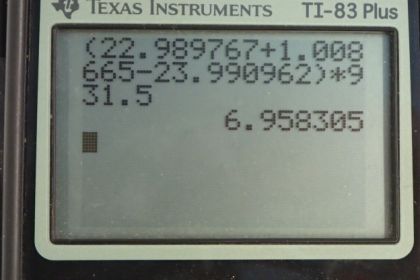Question
(a) Neutron activation of sodium, which is 100% , produces , which is used in some heart scans, as seen in Table 32.1. The equation for the reaction is . Find its energy output, given the mass of is 23.990962 u.
Final Answer
Solution video
OpenStax College Physics for AP® Courses, Chapter 32, Problem 7 (Problems & Exercises)

vote with a rating of
votes with an average rating of
.
Calculator Screenshots
Video Transcript
This is College Physics Answers with Shaun Dychko. Neutron capture by sodium-23 produces sodium-24 and a gamma ray and our job in part (a) is to find out what is the energy released in this reaction most of which will be in the form of this gamma ray but some of the energy will be in the excited state of this sodium-24 nuclide. So we have the atomic masses of sodium-23, atomic mass of a neutron and atomic mass of sodium-24 and we'll find the energy released is the difference in the total mass that we start with—sodium-23 and the neutron— minus the mass that we end with which is sodium-24 and then we'll convert that mass into energy by multiplying by c squared. So we have the atomic mass of sodium-23 plus that of a neutron minus sodium-24's atomic mass and convert those atomic mass units into megaelectron volts per c squared then multiply by c squared giving us 6.958 megaelectron volts of energy released in the neutron capture by sodium-23. Then in part (b) we are asked how much mass of sodium-24 is needed in order to have a particular radioactivity that we are given and radioactivity is 5 millicuries. So activity is natural logarithm of 2 multiplied by the number of nuclei divided by the half-life of that particular nuclide and we'll substitute for this capital N using this formula which says we have the mass which is what we are trying to find divided by the atomic mass and that gives the number of mols and then multiply those mols by Avogadro's number which is the number of nuclei per mol. And so we'll solve this for well it's already solved for capital N and we substitute that into our activity formula which is formula [31.45]. And then this needs to be rearranged to solve for little m the mass of sodium-24. So we multiply both sides by atomic mass times half-life divided by natural logarithm of 2 times Avogadro's number. So we have the mass then is the activity times the atomic mass times the half-life divided by natural logarithm of 2 times Avogadro's number So that's 5 millicuries which is the activity we require for this brain scan and we convert that into an mks unit of becquerels by multiplying by 3.7 times 10 to the 10 becquerels per curie and then multiply that by the atomic mass of sodium-24 and then the half-life we are told is 15 hours but we need the hours to be an mks unit of time which is seconds and so we multiply by 3600 seconds per hour then we divide by natural logarithm of 2 times Avogadro's number and we get 5.7 times 10 to the minus 10 grams of sodium-24.

